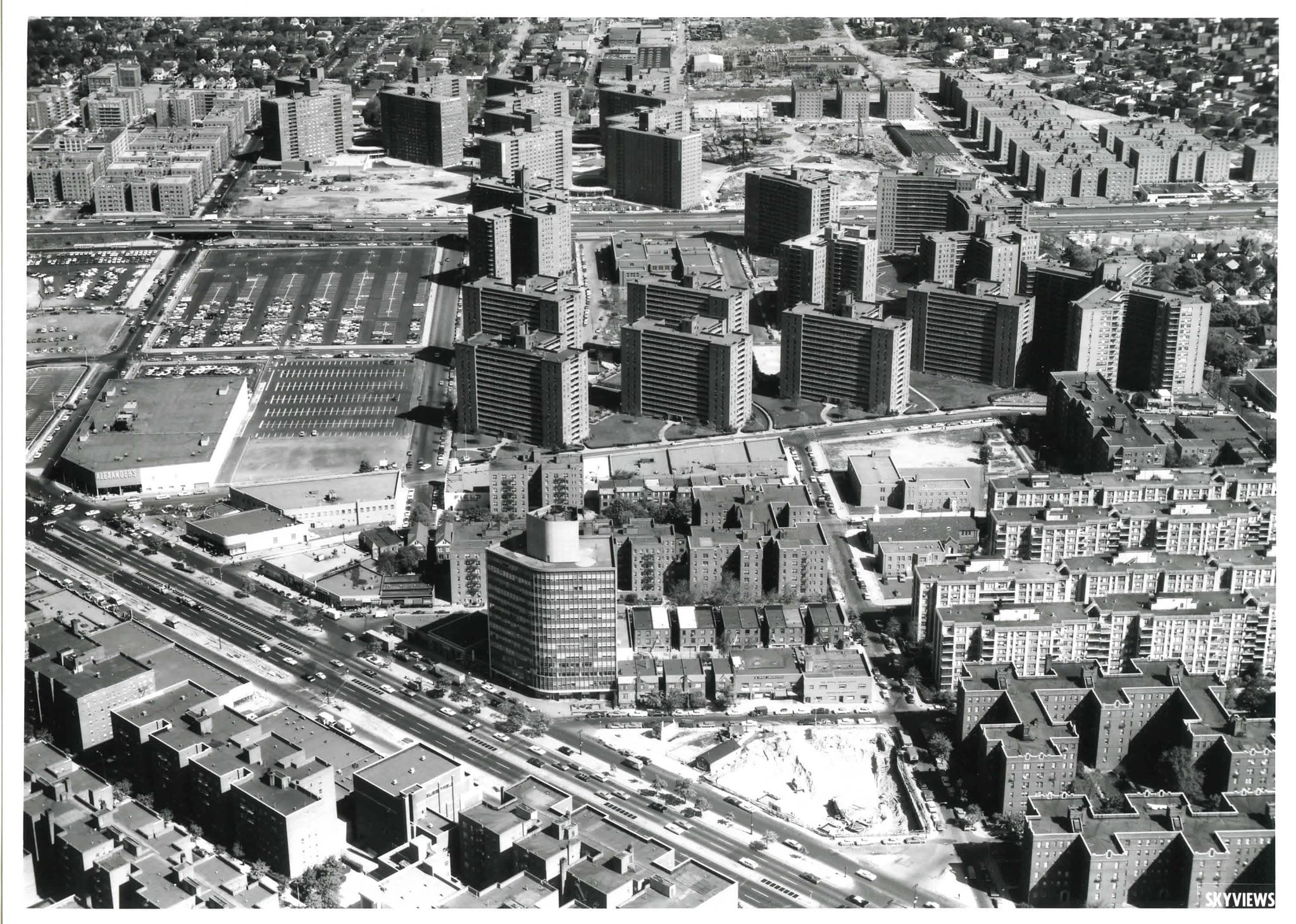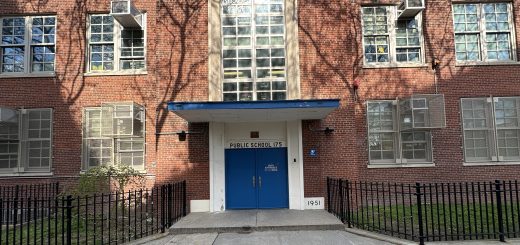Eyeing Historic Garden Apartments on Rego Park Centennial
Views: 362
Queens Boulevard Gardens & Walden Terrace, Two Novelties

By Michael Perlman
At the time of Rego Park’s centennial, it is timely to gain a renewed appreciation for garden apartment complexes that are home to thousands of residents and a model of urban planning. Two architecturally and culturally significant early examples that are neighbors and occupy several blocks in Rego Park are Queens Boulevard Gardens, also known as Queens Gardens, and Walden Terrace. Together, they form a desirable community within a community, with a suburban feel.
The establishment of the IND subway in 1936 along Queens Boulevard and the 1939 to 1940 World’s Fair in nearby Flushing Meadows, contributed to a population boom. It also increased the demand for garden apartment complexes, designed with attractive architectural features, amenities, and generous spaces for landscaping and recreation, which families would be proud to call home. Forest Hills High School, which opened in 1941, was another draw.
Queens Boulevard Gardens consists of 18 harmonious garden-style apartment buildings, spanning four apartment groups to accommodate 540 families, and is situated on a highest point of Queens Boulevard. The boundaries are 64th Road, 98th Street, 99th Street, 65th Avenue, 65th Road, and Queens Boulevard. It was announced that they would operate under the Federal Housing Administration (FHA) rental housing plan. They were erected from 1938 to September 1939 under a development firm headed by Robert Meyer and Ernest G. Simon. Patrick J. Dwyer was the builder, and the architects were Bronx native Charles Kreymborg and Ralph Pomerantz & Breines. Charles Kreymborg also designed Art Deco buildings, including 1210 Sherman Avenue in the Bronx, erected in 1937 and the landmarked 860 Grand Concourse, erected in 1941, among others in the Grand Concourse Historic District.
The visionaries took pride in American history and named all buildings after States of the Union. The first apartment group consisted of Texas, Montana, Washington, New York, and New Jersey, whereas the second apartment group consisted of Nevada, Colorado, Arizona, Delaware, and Kansas. That was followed by a third group named after Indiana, Vermont, Illinois, and Ohio, and a fourth group named after Louisiana, Michigan, Missouri, and Utah. Historically, the land was part of a large tract assembled from local farmers only three decades prior. Residential planners felt it was worthwhile to wait until improved transportation materialized.
Queens Gardens is an attractive example of Colonial and Elizabethan design. Unifying features include quoins, as well as brick patterns and central limestone and curved wrought iron capping the parapet. Arched entryways with a limestone surround featuring a pediment adds a welcoming touch. From a distance, castle-inspired roof huts elevate one’s senses. Queens Gardens occupies one-third of six acres, enabling well-manicured private gardens, (former) children’s playgrounds with sandboxes, and maximum sunlight and cross-ventilation. Many trees are original to the property, including a stately American Elm tree on Queens Boulevard. They are joined by colorful Crepe Myrtles, Maple, Oak, and Evergreen trees. Pathways along large landscaped lawns lead to arched tunnels and courtyards to access other apartment building entryways, creating a serene oasis away from the bustling Queens Boulevard. Garages were another selling point. A September 10, 1939 New York Times ad advised prospective tenants to “Compare the layouts, the location, the equipment, the rentals with any other new apartment.”
An original prospectus, with cartoon illustrations, explained what better living meant – “Coverage of but one-third the area with buildings assures maximum amount of sunlight. Each and every room of all apartments faces front” and “Four acres of beautifully landscaped gardens provide that pleasant suburban atmosphere – so rare in the metropolitan area.”
Early appealing features were also G.E. refrigerators, radio outlets, 18 Otis elevators, where each served 25 apartments, garages with direct entrances to the building, black and white tile bathrooms, public foyers on floors accommodating five apartments to maximize privacy, sound-proofed partitions, and each apartment offering a minimum of two exposures, offering cross-ventilation.
On August 18, 1940, The New York Times interviewed Leonard S. Gans, treasurer of Wm A. White & Sons and president of Kerr-Gans, Inc. He stated, “Not even the most optimistic real estate broker could vision ten years ago the scope of the improvements which would come during Depression years as an aftermath of the new subway operation.” Kerr-Gans was a sales agent for the interests for the original landowners, where Queens Gardens and the nearby garden-style Thorneycroft apartment group (completed in late winter of 1939) are situated. The large tract was undeveloped for many years. As rentals were in high demand, this apartment house community was referred to as prosperous. The total area of both developments is 1,815,000 square feet.
The environment fostered neighborliness based on its accommodations. For example, on July 28, 1943, the Long Island Star-Journal reported that an illustrated lecture on the proper technique of home-canning would be delivered at a meeting of the Consumers Club of Queens Gardens in the Air Raid Wardens’ headquarters at 65-10 99th Street. WWII-inspired Victory Gardens were situated nearby along 99th Street.
An August 4, 1940 New York Times ad referenced another selling point, where it was 15 minutes into Manhattan with a five-cent fare. “Elevator apartments” were an attraction, with three rooms from $56, four rooms (Jr.) from $60, and four and a half rooms with two baths from $75. Half rooms and dining rooms are junior rooms with a window, utilized for dining, small studio rooms, and children’s rooms.
Walden Terrace, an 8-story, 12-building International style apartment rental complex was designed for families with a middle income in 1948. The complex is featured in Historic District Council’s new Six To Celebrate publication, “A Guide To Historic New York City Neighborhoods – Rego Park.” Furthermore, the AIA Guide To New York City, initially published in 1968, featured Walden Terrace as a highlight.
The complex overlooks 98th Street, 63rd Drive, 99th Street, 64th Avenue, and 64th Road. It features 880 rental apartments, situated in rows, where most overlook a central garden and playground accessible from the street. It is a superb example of mid-century urban planning and was deemed a novelty. The facades are an elegant example of sleek lines displayed in horizontal and vertical bands.
Walden Terrace was advertised for its dropped living rooms with room-sized railed dining galleries, all rooms off large foyers, large streamlined balconies, parquet floors, poured reinforced concrete to achieve fireproof construction, cross-ventilation, as well as being 20 minutes from Radio City on the Independent Subway. The buildings consist of 2 to 5 rooms and garages, and were also advertised for their free gas, electricity, and master TV. Rents ranged from $85 to $175. Accessibility to the finest shops, schools, and places of worship was another draw.
Among its early residents were actor, comedian, composer, and saxophonist Sid Caesar (1922 – 2014), born Isaac Sidney Caesar. As of 1949, he resided at 98-10 64th Avenue, and could be spotted shopping along Queens Boulevard in the 1950s. He was Coach Calhoun in “GREASE.” Another notable resident was actress Ina Balin (1937 – 1990), who won a Golden Globe for “From the Terrace” starring Paul Newman. At 98-34 63rd Drive, it was the childhood home of TV, film, stage, and voice Hank Azaria (born 1964), who is best known as the voice behind Moe Szyslak on “The Simpsons.”
A significant percentage of the tenants were WWII veterans, according to a June 27, 1948 New York Times article. Based on 440 heads of families queried as to how they earned a living, 77 owned a business, 332 were engaged in various kinds of business activity, and 31 were professional men in the legal, accounting, and engineering fields.
On January 11, 1948, The New York Times stated, “In planning the buildings, Leo Stillman, architect, and Victor Mayper, engineer, used these large window areas not only for utilitarian qualities, but also to blend in with aluminum spandrels and the balconies in an unusual architectural décor against the façade background of limestone-finished concrete.” Walden Terrace was developed by the Nipark Realty Corporation, where David Rose served as president. He was an active investment builder since 1922 and erected over 5,000 apartments in Queens, Manhattan, the Bronx, and Connecticut. An ad from the same date read, “New 8-story fireproof buildings…Forerunner of a new trend in apartment design.”
A WWII-developed technique of fastening to concrete was utilized. No structural steel, including I-beams, angle irons, or girders was needed, resulting in a reservation of time and costs, according to the builder. He praised the rapidly poured concrete, partitions with large units of gypsum blocks and sheets of gypsum lath and sound insulation, factory assembled metal door frames and on-site machinery that fostered highly efficient structural work.
Architect Leo Stillman (1903 – 1989), a native of Russia, was acclaimed for his Art Deco projects of the 1930s, followed by his innovative use of poured concrete in apartment building development. In the 1920s, he studied at Beaux Arts Institute of Design and City College of New York. He was also noted for dropped living rooms and six-story apartment houses situated in clusters overlooking a courtyard, such as Park Terrace Gardens in Manhattan and Oxford Knolls in the Bronx. One outstanding example of his work in the Renaissance Revival style with elaborate terra details is the landmarked 825 Gerard Avenue, erected in 1928. Stillman’s works can be found in the Grand Concourse Historic District.
Walden Terrace photos were featured in a New York Times ad on April 10, 1949 titled “Such stuff as dreams are made on… a bold new architectural concept.” It listed numerous collaborators which resulted in a superb achievement, including concrete construction by Moccia Construction Corp, masonry by Sam Ralph, painting and decorating by Metro Decorating Co, ornamental iron by L.K. Iron Works, and aluminum spandrels and balcony rails by Reynolds Metal Company. An excerpt read, “Now Walden Terrace is an actuality. Not long ago it was a thick batch of architectural drawings and engineering data… the builder’s concept expressed on paper… developed by Leo Stillman, the architect, Victor Mayper, the engineer, Moreno & Robinson, the landscape architects, and Mark Rafalsky & Co, the renting agents, with imagination and with skill… with bold creativeness and enormous technical mastery.” It later referenced, “a dramatic and daring architectural achievement that will influence design and construction for long decades to come!”
| ReplyForward |




Ԍreetings! I’ve been following your weblog for some time now and finally
got the bravery to go ahеad and give you а shout out from
Ꮲorter Texas! Just wanted to tell you keep սp tһe excellent woгk!
How can I contact you, the fact is that I have been developing this topic for a long time and it is very pleasant to find like-minded people.
Sure. And I ran into this. Let’s discuss this issue.
The fact that I came across this post by accident led me to believe that it was an excellent one.